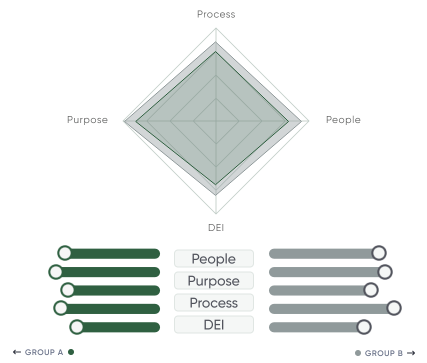3 Tools to Measure Your Company Culture

Related Insights
While measuring a company’s culture may seem like a daunting task, below are three tools to assist you in doing so. These tools will help you establish a baseline understanding of your culture and stay informed as your organization goes through inevitable changes. The information gained will also assist you in creating an intentional culture for your organization moving forward.
1. Culture Surveys
Culture surveys might be the first tool that comes to mind when assessing company culture. They provide a great baseline to understand the strengths and weaknesses of your culture. One of the benefits of using a culture survey is that it provides objective measures of your culture’s strengths and weaknesses. You can then compare these benchmarks against future survey results to track progress. While your culture cannot be conflated to a single number or a series of numbers, these concrete metrics are useful in bench-marking your organization, understanding the changes that take place within your team, and monitoring progress over time. Every team experiences changes and point-in-time measures are an indication of whether your culture is improving or not.
One aspect of a culture survey to be mindful of is that they often focus exclusively on the “people” side of the equation by assessing engagement, communication, feedback, and motivation, but neglect to include the systems and processes that allow (or restrict) work from being done.
For example, the Chapman & Co. Organizational Culture Survey was created from academic research and industry experience to provide insight into three areas critical to organizational success: interpersonal dynamics, the explicit and implicit sense of purpose and direction in the organization, and the processes that enable work to be accomplished. Within any organization, behaviors drive systems and systems drive behaviors, so it is important to choose a survey that addresses both.
2. Focus Groups
One downside of a culture survey is that it only measures broad areas of your culture. This isn’t necessarily bad, because if they dove into every detail, the survey would be hundreds of questions long. However, the strengths and weaknesses that are identified in the survey serve as a starting point, which leads to the second tool on how to assess your company culture: a focus group.
If an area of improvement surfaces from a survey, it can be helpful to gather a cross-section of your organization for 30 to 60 minutes to better understand and contextualize the issue.
To do so:
- Determine the relevant groups. If an issue pertains only to a certain department or location, it probably doesn’t make sense to invite employees outside of those groups.
- Invite a cross-section of employees. Often, problems within a team are multi-faceted and many individuals across the organization can offer insight. If your sales process surfaces as a problem, involve your Sales, Marketing, Research, and Development teams, and any other groups or individuals involved.
- Organize as many focus groups as necessary but keep them to a manageable size. Anything over thirty people can be challenging because you want to ensure everyone can share and be heard.
- Ask for stories and behaviors, not opinions or rumors. Stories focus the conversation and avoid generalizations and exaggerations. “This company punishes anyone who speaks up” is very different from “When I shared my thoughts during our Monday project meeting, I was told after the meeting by my manager that I need to stay focused on the agenda instead of thinking of different ways to do things.” The former lacks specificity, while the latter offers specific areas for follow-up.
- Practice empathetic listening. Listening can facilitate more powerful conversations. Doing so encourages employees to share more and makes them feel valued, which in turn provides you with a better understanding of the issue and increases employee buy-in to fix the problem.
- Thank each person after they have shared. Even if you disagree, their story is their truth.
3. Regular Check-Ins
Finally, pulse surveys and recurring one-on-one meetings with your team are a great way to stay in touch with your company’s culture on an ongoing basis. Pulse surveys are often an additional service that survey providers offer, and they allow you to monitor specific aspects of your culture on an ongoing basis. This helps track progress toward your cultural goals on a more frequent basis than once a year when you run a full culture survey.
Recurring one-on-one meetings with your team, not only allows you to provide feedback and coaching, they allow your team to do the same.
A few tips for these conversations:
- Ask open-ended questions. Generally, the more open-ended your questions are, the more detailed information you’ll receive. Often, closed-ended or leading questions serve to reinforce our perceptions instead of expanding it to understand the other’s experience of the company’s culture. Open-ended questions lead to better information, which helps you lead more effectively to drive culture change.
- Practice empathetic listening. As mentioned above, this helps both in focus groups and in one-on-one meetings.
- Follow up on themes from previous culture surveys. In addition to focus groups, regular check-ins are a great place to dive deeper into themes of a recent survey. Sometimes the one-on-one setting allows employees to share information that they won’t in a group setting.
Surveys, focus groups, pulse surveys, and individual meetings all serve as tools to help you better understand your company’s culture. Then, once you’ve done the work to assess your company culture, you’re better informed to reinforce what is working and change what is not. Assessing your culture is the first step. Taking action to build a stronger culture is next.





